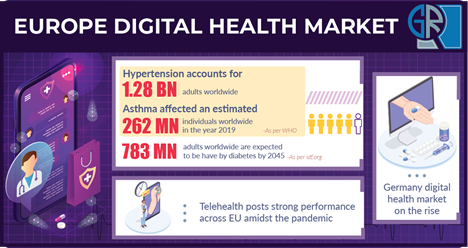Characterized by strong R&D developments and investments, Europe digital health market has undergone a significant change in the last few years. Following the COVID-19 pandemic, the rising burden of noncommunicable diseases (NCDs) in region has necessitated the development of novel methods for chronic illness management. COVID-19 restrictions have also limited access to healthcare and imposed a significant strain on economies, prompting governments to seek digital alternatives to improve the quality of health services and make them more responsive to people's needs.
In 2020, the EU4Health program was introduced to promote COVID recovery by increasing health system resilience and fostering medical innovation and digital transformation. It is projected to operate through 2027 and will have a budget of €5.3 billion to enhance and promote health in the European Union (EU). In addition, in 2021, the European Health and Digital Executive Agency (HaDEA) was established to oversee digital and health programs aimed at assisting Europe in emerging stronger from the pandemic.

>
- Role of digital healthcare in treating chronic diseases:
Chronic, lifestyle-related illnesses are putting an increasing strain on the world's healthcare systems. Have a look at the statistics mentioned below:
- According to idf.org, around 537 million adults have diabetes, and this number is expected to climb to 783 million by 2045
- According to the World Health Organization (WHO), hypertension affects an estimated 1.28 billion adults globally
- According to the WHO, asthma is the most prevalent chronic condition among children, affecting an estimated 262 million individuals in 2019
These figures are expected to rise as the population ages. The WHO predicts the world's population of people aged 60 and above to reach 2 billion by 2050. To ensure the sustainability of healthcare systems, there is an urgent need for digital health solutions that can detect, diagnose, and treat diseases earlier and more effectively: or, even better, prevent patients from getting chronic disease in the first place.
Many people with chronic diseases find that apart from conventional treatment, support groups make a significant difference. Recognizing this, the Elsa Science app was created in Sweden to connect patients who want to share their experiences, learn more about their disease, and take an active role in their health treatment. In many more innovative ways, digital health technologies can be used to ensure that healthcare is equally distributed, reachable and accessible to all. One of the ways this this goal can be easier achieved is through the incorporation of telehealth.
- Telehealth posts strong performance across EU amidst the pandemic:
Since the beginning of the COVID-19 pandemic, European public authorities have increasingly relied on digital technologies such as telehealth, to allow virtual patient-doctor consultations and monitor epidemics. As we are slowly returning to normalcy, Europe is capitalizing on the power of digital healthcare with the goal of encouraging digital solutions for citizen integrated care, allowing breakthroughs, and securing the region’s global competitiveness in healthcare.
For instance, France digital health market trends are showing substantial promise for growth, considering the government’s growing emphasis on eHealth. The nation is planning to roll out electronic health records (EHRs) throughout the nation, leveraging AI, and establishing a data hub for healthcare data. In 2021, the country even began its trials for a digital vaccine passport.
Maintaining and extending telehealth services will be crucial to assuring access to care while reducing exposure to SARS-CoV-2, as the COVID-19 pandemic progresses. Services offered by telehealth service providers such as Doctor Care Anywhere, Babylon Health, and KRY are replacing brick-and-mortar GP consultations. As such, traditional healthcare practitioners including GPs are offering their own virtual care services through telehealth platform vendors. Doctolib, LIVI, Platform24, eConsult, and Pharmeon are some examples if telehealth platform vendors in Europe.
- Germany digital health market on the rise:
Throughout the pandemic, Germany has firmly remained at the forefront of adopting digital health technologies, by constantly developing and adjusting laws. DiGA Fast-Track was established in 2019 as a result of the Digital Healthcare Act (DVG) and other legal reforms, which meant that applications could be prescribed by physicians and expenses could be paid through German health insurance. More recently, in May 2021, the Digital Healthcare and Nursing Care Modernisation Act was passed for further expansion of telemedicine, digital health applications, and health apps.
The World Health Organization (WHO) and the European Union (EU) both called for the use of health technology to eliminate disparities and enhance health and wellbeing in 2019. The European Program of Work for 2020–2025, titled "United Action for Better Health," establishes goals for the future of healthcare in Europe and recognizes digital health as a critical component to achieving this vision.


